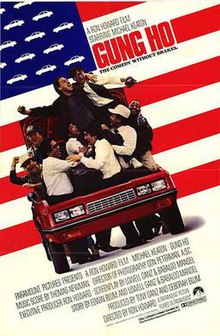- What is going on in the opening
scene? What does the screaming
indicate about the “Japanese work culture”?
Michael Kenton
has a meet with Japanese leaders to make business. Japanese are very serious
and strict and do not get Kenton’s jokes.
- Describe two cultural differences
Micheal Keaton encounters when he meets the Japanese Board of Directors.
a) Japanese
are more formal.
b) Japanese
are more serious about money issues and business.
- Why did Micheal Keaton go to
Japan? What were the problems with
his home town of Hadleyville?
Michael Kenton
went to Japan to sell the Assian managers on the idea of coming to Hadleyville
and reopen the factory. The problem was that Hadleyville factory has been
closed for the last nine months and lots of people has lost their jobs.
- How does the car factory closing
affect the town of Hadleyville?
What is the evidence is shown in the grocery store scene to
illustrate the problems?
A great plenty
of people in Hadleyville work in the car factory, so they may lost their jobs.
- Why was Micheal Keaton promoted?
Michael Kenton
was promoted to work as a liaison between the Japanese management and the
American workers, to make the transition easier for both and convince the workers
to obey the new rules.
- Describe what is occurring at the
workers’ meeting.
American
workers do not want to work for Japanese people, get lower pays and have to
work harder. Michael Keaton takes an important role and promises to discuss and
make the transition easier.
- Describe four cultural differences
that occur on the first day of work.
Why are the American workers laughing?
a) Japanese
executives eat their lunches with chopsticks
b) Japanese
executives bathe together at the river
c) Kazihiro says
that they are a team and they should work as a team.
d)
Callisthenics in the morning.
American
workers laugh because it is strange for them these things and do not get the
point of doing callisthenics in the morning.
- Why do the Japanese install close
circuit cameras in the factory?
What does this indicate about trust?
This way
Japanese can keep an eye on the USA workers. Japanese people do not trust the
American.
- How does the music in the factory,
the newspaper in the bathroom and smoking by the American workers contrast
with the Japanese factory culture?
Japanese are
shown very loyal to the job. They work hard and with no distractions at the
workplace. All the funny things happen outside the timework.
- Why do the Japanese initiate a job
rotation among the factory workers?
Because this
way every work can learn every job. Although, they are held to seemingly
impossible standards of efficiency and quality.
- How important is quality to the
Japanese? What evidence is there
to support the importance of quality?
How does the focus on quality contrast with the workers old-style
culture?
Quality is the
most important thing for Japanese.
The Assan boss
revises all the cars one by one.
Old-style
workers only want to have work done to get paid. They do the minimum they can
do.
- State the differences between the
factory workers and the management teams at the baseball game. What does the differences between the
two groups signify?
Buster cheats
when he intentionally knocks a man down. Rather than contest the incident, the
Japanese accept the loss and leave. The American workers want to win anyway and
the Japanese want to win but following the rules.
- Why do the women leave the table at
the dinner party? Why does Keaton’s
spouse get upset about this?
Because they
think business is only for men and women have nothing to say about them.
- Why is Micheal Keaton fired?
Michael Keaton
is fired because he did not reach the goal at time.
- Why does Keaton meet the Japanese
management team in the river?
Because the Japanese
man is going to suicide himself. But rather than focusing on their differences,
they decide to focus again on their shared goals and return to the factory to
build more cars.

No hay comentarios:
Publicar un comentario